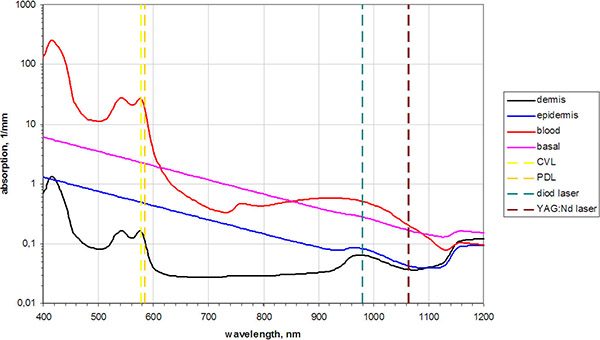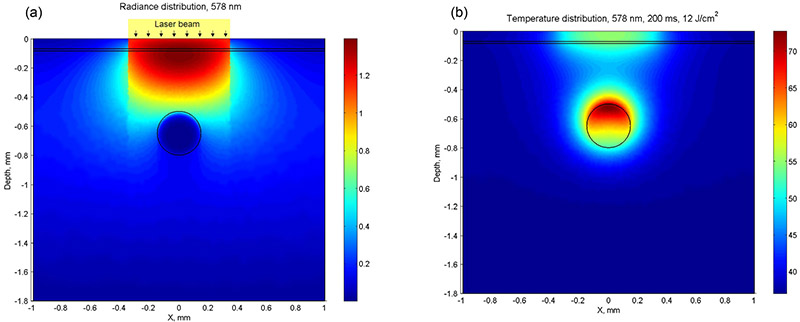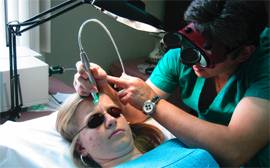Selective Photothermolysis
Let see the light absorption spectra of the
cutaneous skin chromospheres
(Fig.1). Yellow and green lights are
highly
absorbed by melanin and a little absorbed by water. Some wavelengths in
green and yellow spectra are strongly absorbed by hemoglobin and oxyhemoglobin and
therefore by blood vessels. Infra-red light is absorbed
by water, however melanin and hemoglobin almost not absorb it. Choosing the
right wavelength, we can
selectively heat the target
chromophores of the skin.

Fig 1. Absorption spectra of
skin chromophores:
hemoglobin; melanin.
Choosing the wavelength in green-yellow spectra near the absorption
maximum of hemoglobin and oxyhemoglobin we can
selectively heat the abnormal cutaneous
vessels (telangiactasias, port-wine stains)
by short
laser pulses without injuring of the
surrounding tissue. This treatment is called selective laser coagulation
based on the principle of selective photothermolysis first discovered by
R.R. Anderson and J.A. Parrish.
According to the concept of selective photothermolysis for removing abnormal blood vessel it's necessary to meet some demands:
laser wavelength must coincident with the yellow absorption peak of
hemoglobin and oxyhemoglobin Ц 577 nm; laser light spot must compare with the diameter of abnormal vessels
(about 0.1 - 1 mm); pulse duration must be
shorter than thermal relaxation time of
target vessels; laser power must be sufficient to provide the effect of selective
photodestruction.

Fig.2. The
Calculated Distribution of Light Intensity at a 578-nm copper vapor
laser Wavelength in the Arbitrary Unit (a) and Calculated Temperature
Distribution at the end of CVL Exposure Time of 200 ms (b). Vessel
diameter Ц 300 microns, vessel depth Ц 500 microns.
The copper vapor laser system Yachroma-Med well satisfies all this demands.
The copper vapor laser seems to be the optimal approach to the laser treatment
of vascular and pigmented lesions due to the high absorption of the 511 nm
radiation by melanin and due to the high absorption of the 578 nm radiation by
oxyhemoglobin.
The use of pulsed yellow light at 578 nm allows achievement of maximum
efficiency when heating the dysplastic vessels of vascular skin lesions.
10-times higher fluences are needed for heating vessels to the
coagulation temperature when using Nd:YAG and diode lasers.
You can find more
information about selective blood vessel heating by different lasers in our paper
Comparative
numerical analysis and optimization of blood vessels heated using
various lasers Authors: Pushkareva, A. E.; Ponomarev, I. V.; Topchiy, S.
B.; Klyuchareva, S. V. 2018 Laser Physics
Thousands adults and children have been treated effectively with Yachroma-Med.
Thus it has been shown that Yachroma-Med save and effective laser system for the
treatment of cutaneous vascular lesion.
You can find more
information about selective blood vessel heating by different lasers in our paper Numerical
Modeling and Clinical Evaluation of Pulsed Dye Laser and Copper Vapor
Laser in Skin Vascular Lesions Treatment
Authors: Klyuchareva, S., V; Ponomarev, Igor, V; Pushkareva, A. E.
Published: 2019 in Journal of Lasers in Medical Sciences
DOI: 10.15171/JLMS.2019.07
Back to the top
|

